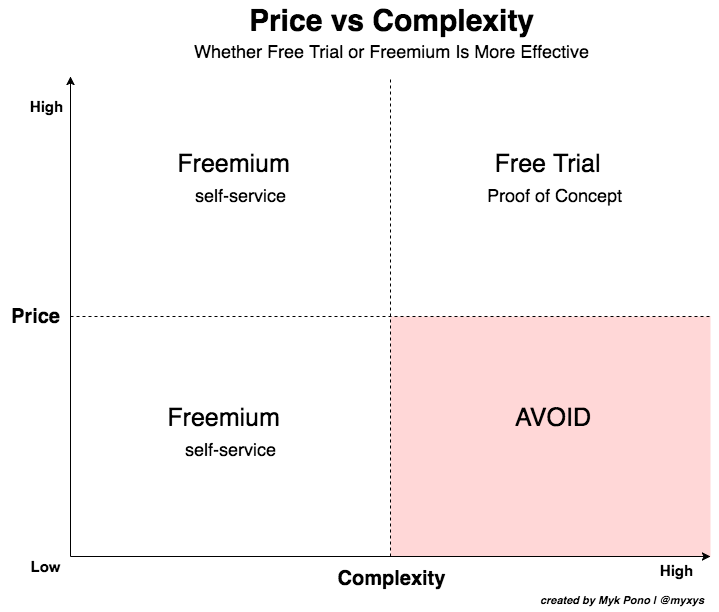Why Do Companies Fail With Freemium? – The Startup – Medium

7 Reasons why companies fail with freemium
Note: this article represents a section of the larger and in-depth article — Freemium vs Free Trial vs Hybrid Customer Acquisition Model in SaaS.
Let’s review a few of the most common reasons why SaaS companies fail with a freemium model.
#1 Provide no or little incentive for free customers to convert
Giving away too much of the product is one way to fail with freemium. Assuming that the cost to service free customers is low, companies must strike a careful balance. They need to provide access to just enough of the product to continuously derive value but not quite enough to eliminate the incentive for users to buy the product. The goal of the freemium is to entice customers to increase product usage and essentially to convert to a paid subscription.
#2 Don’t deliver enough value
If you provide features that are of low importance to the user, or limit you free version to the level where no value can be extracted from the product, you will most likely fail. Even if you provide your product free of charge, users still have to derive some value from it. For example, if SurveyMonkey allowed just one question per free survey, it’s unlikely anyone would find enough value to use the tool. What’s more, fewer survey responders would be exposed to the SurveyMonkey product and brand.
#3 Don’t create a sense of urgency
One of the main criticisms of the freemium model is that it doesn’t create a sense of urgency. A free trial expires, which creates urgency for users to invest the time to user and learn about the product value. However, companies can craft freemiums that highlight the urgency factor.
Analyze your freemium users and categorize them into three buckets:
1. Not ideal customer to get the full value for your product
2. Too small with no budget
3. Ideal customer with a budget but low usage
No matter how good your product is, it will never be the case that everyone finds enough value to buy it. Thus, not everyone is the ideal customer. Plus, not everyone has the budget. These free customers can still love your product and share positive reviews. They can be influencers and promote your product and related content across social media but conversion to paid customer might never happen. Therefore, focus on building urgency with the third category of free users who fit your ideal customer profile, have budget, but most likely do not yet use your product enough to pay for it.
You can create the urgency by communicating about new premium features that deliver more value or by highlighting the value missed by not having access to a premium subscription.
#4 Don’t nurture and engage continuously with prospects, resulting in a lower free-to-paid conversion rate
Too many companies overlook the importance of nurturing free customers while highlighting the differences between their free and paid versions. Instead, they rely on the idea that free customers will understand the product value and will convert themselves over time or as their needs grow. Companies have to continuously educate users on how they can get more benefits from the paid version of the product. It’s worth it to educate about new releases and product upgrades.
#5 Don’t track and analyze insights on how and why customers convert
This is related to the previous point. Companies need to outline a clear path to take free users to paid customers. It’s a mistake to think that free users don’t need to be analyzed or tracked. First, tracking free users can help you understand target customers better and create data-driven research content. For example, say your product tracks mobile app performance and collects uptime and the most common issues related to downtime. Your company could use this data to create an industry report showcasing uptime for each mobile app category. This type of customer usage-driven content is extremely effective in marketing and PR.
#6 Don’t provide appropriate onboarding experience
Even with the free version of your product, users will need to learn how to use your product. Remember, “empty state” or “zero data” is what prospects see during their initial signup process when no data is available in the product.Providing free access to your product that looks empty isn’t going to help you convert free users to paid customers. This is all part of onboarding, which is critical for successful product adoption and can also guide prospects through the steps to generate more data so they realize even more product value.
#7 Don’t evaluate the cost of supporting free customers
We talked about the cost of a freemium offering. It can quickly add up when considering all your costs, everything from cloud storage to support. Communicate to your users what’s included and excluded in the free version of the product. Ensure that your costs are manageable in the long term.
Read the full article: Freemium vs Free Trial vs Hybrid Customer Acquisition Model in SaaS.
If you like this article please recommend and share.
Follow me on Twitter, Medium, Quora, Instagram, MykPono.com, connect on Linkedin.
Join my Telegram channel — Marketing Journal — to discover interesting articles, books, and resources on marketing, product growth, startups, and SaaS.


